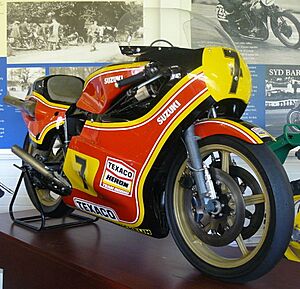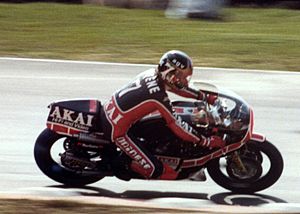Barry Sheene facts for kids
Quick facts for kids Barry SheeneMBE |
|||||||||||||||||||||||||||||||||
|---|---|---|---|---|---|---|---|---|---|---|---|---|---|---|---|---|---|---|---|---|---|---|---|---|---|---|---|---|---|---|---|---|---|

Sheene in 1975
|
|||||||||||||||||||||||||||||||||
| Nationality | British | ||||||||||||||||||||||||||||||||
| Born | 11 September 1950 London, England |
||||||||||||||||||||||||||||||||
| Died | 10 March 2003 (aged 52) Gold Coast, Queensland, Australia |
||||||||||||||||||||||||||||||||
|
|||||||||||||||||||||||||||||||||
Barry Sheene (born September 11, 1950 – died March 10, 2003) was a famous British professional motorcycle racer. He competed in Grand Prix motorcycle racing, which is the highest level of motorcycle racing.
Barry Sheene became a two-time world champion. He won the 500cc titles in a row, first in 1976 and then again in 1977. His 1977 win was the last time a British rider won a solo motorcycle world championship until Danny Kent won in 2015.
After racing from 1968 to 1984, he stopped competing. He moved to Australia and became a motorsport commentator. He also worked as a property developer.
Contents
Early Life of Barry Sheene
Barry Sheene was born in London, England. His father, Frank, was a skilled motorcycle mechanic. Frank had also been a competitive motorcycle rider himself. Barry grew up in Holborn, London. Before he started road racing, Barry worked as a messenger and delivery driver.
Barry Sheene's Racing Career
Barry Sheene started racing motorcycles in 1968. He won his first races at Brands Hatch on bikes his father owned. By 1970, at just 20 years old, he became the British 125cc champion. He rode a Suzuki factory racing motorcycle he had bought.
In 1971, he finished second in the 125cc World Championship. He won his first Grand Prix race in Belgium that year. He also won a 50cc race in Czechoslovakia.
For the 1972 season, Sheene joined Yamaha. He rode a factory-supported bike for the 250cc World Championship. During this time, he broke his collarbone in a practice crash. This injury kept him from racing for several months.
Sheene then signed with Suzuki for the 1973 season. He won the new Formula 750 European championship for them. In 1974, Suzuki introduced the RG500 bike. Sheene rode it to several top finishes. He also won the important Mallory Park Race of the Year.
In 1975, Barry had a very serious crash at the Daytona 200 race. He broke his left leg, right arm, collarbone, and two ribs. Even with these severe injuries, he recovered quickly. He was back racing just seven weeks later! He then won his first 500cc race in the Netherlands.
The 1976 season was amazing for Sheene. He won five 500cc Grands Prix. This earned him his first World Championship. He won the championship again in the 1977 season with six more victories.
One of his most famous races was against Kenny Roberts at the 1979 British Grand Prix. Many people remember it as one of the best races of the 1970s. After 1979, he left the Suzuki factory team. He then rode for Yamaha.
In 1981, Sheene was determined to win the championship from Kenny Roberts. They battled all season, but other riders ended up taking the top spots. Sheene's win at the 1981 Swedish Grand Prix was the last for a British rider in the top category for many years.
Barry Sheene had another bad crash in 1982 at Silverstone. He hit another fallen rider's bike during practice. This crash badly injured his legs. He had surgery that saved his legs, but it largely ended his chances of winning another title. He retired from racing in 1984. He is the only rider to win Grand Prix races in both the 50cc and 500cc categories.
Sheene was known for speaking out about dangerous race tracks. He believed the Isle of Man TT course was too risky for world championship races. He was a lively and popular person. He used his charm and London accent to promote himself. He was one of the first riders to earn a lot of money from endorsements. He helped make motorcycle racing more popular with the public.
Life in Australia
The Sheene family moved to Australia in the late 1980s. They hoped the warmer weather would help with Barry's arthritis pain from his injuries. They settled near the Gold Coast. Barry started a property development business. He also became a popular motorsport commentator on TV. He covered the Grand Prix series and other motor sports like V8 Supercars.
In the 1990s, Sheene appeared in popular TV advertisements for Shell. He starred alongside Australian racing driver Dick Johnson.
In his later years, Sheene enjoyed racing historic motorcycles. He often returned to England to race at Donington Park. His last UK race was at the Goodwood Revival in 2002. He was also chosen to carry the Queen's Baton for the 2002 Commonwealth Games in Manchester, England.
Death
In July 2002, when he was 51, Barry Sheene was diagnosed with cancer. He chose to try a natural approach to treatment. He died in a hospital on Australia's Gold Coast in 2003, at the age of 52. He had been ill for eight months.
Barry Sheene and his wife Stephanie had two children, a son named Freddie and a daughter named Sidonie.
Honours and Awards
After Barry Sheene's death, a section of the Brands Hatch Circuit in England was renamed "Sheene's Corner" in his honour. This was done after the track was made safer. In 2001, the FIM (the international motorcycle racing body) named him a Grand Prix "Legend."
For the 2003 season, the V8 Supercars series created a special award. It is called the Barry Sheene Medal. It is given to the 'best and fairest' driver of the season. Australian motorcyclists also hold a memorial ride each year before the MotoGP race at Phillip Island.
Images for kids
-
Barry Sheene's Team Toyota GB-entered Toyota Supra from the 1985 British Saloon Car Championship at the 2016 Goodwood Festival of Speed
See also
 In Spanish: Barry Sheene para niños
In Spanish: Barry Sheene para niños




